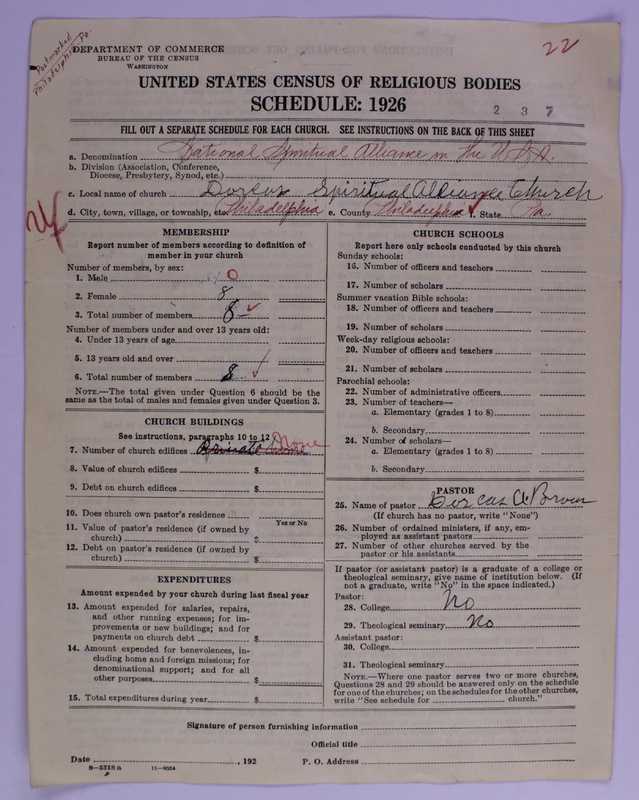Schedule Spotlight: the Dorcas Spiritual Alliance Church
Recently, American Religious Ecologies published the “Male and Female Pastors in the National Spiritual Alliance” map, which shows the location of The National Spiritual Alliance (TNSA) congregations and the gender of the pastor (or lack of pastor) for each congregation. By visually showing both where congregations were located and the preponderance of female pastors in TNSA, we see that female leadership remained important in Spiritualist denominations even as the movement formalized and split. We can give a more human face to these patterns by looking at a single female-led Spiritualist church in Philadelphia.

Figure 1. Schedule for the Dorcas Spiritual Alliance Church.
Dorcas A. Brown was a Black woman and the head of the Dorcas Spiritual Alliance Church; unusually, the church was named after her. Interestingly, the name ‘Dorcas’ has biblical roots; Dorcas was a woman known for doing charity work who was allegedly raised from the dead.1
Brown was born around the year 1882 in Maryland, so likely around forty-four in 1926. She was listed as head of her household in the 1930 census as well as unmarried, and her home was valued at $5,000. She also had a lodger, a man named Ike Jenkins, who was listed as married but seemed to be the only other member of her household. Brown’s occupation was listed as housekeeper; evidently being a pastor did not afford her an income.2 Brown had not attended college or to seminary.
Brown’s church met at her home. On the Census Schedule, the field that asks about the number of church edifices reads “private home,” in black ink. However, the Census Bureau ‘corrected’ this by scratching it out and writing ‘None’ over it in red ink. As the church did not meet in a specific church-only space, the Bureau considered them to have no church edifice. The Dorcas Spiritual Alliance Church had eight members, all of whom were over the age of thirteen years old—and all were women. If the church was located at Brown’s home, her boarder, Ike Jenkins, was not a member.

Figure 2. The field on the schedule asking about church buildings. For ‘number of church edifices,’ the answer ‘private home’ is scratched out. In red, the Census Bureau wrote “None” as a correction..
Early Spiritualists eschewed formalized churches and services in favor of individual practices and expressions. Also, women dominated early Spiritualism, both as mediums who contacted the dead and also as participants. The Dorcas Spiritual Alliance Church, was a small, home-based church, aligning itself with earlier Spiritualist practices in that a small group of women met locally at her home. Brown likely headed the church because of a believed gift in her ability to contact the dead. Looking into this specific church allows a glimpse of what the larger census and the aggregated data cannot do. Even with scant details, we can learn more about a church that was not the typical white and Protestant experience, which dominated the census, but one with a Black female leader in a smaller faith.
New Life Version, Bible, Bible Gateway, Acts 9:36-42, https://www.biblegateway.com/passage/?search=Acts%209%3A36-42&version=NLV. Accessed 14 October 2022. ↩︎
“United States Census, 1930,” database with images, FamilySearch (https://www.familysearch.org/ark:/61903/1:1:XHWW-ZG2 : accessed 3 October 2022), Dorcas A Brown, Philadelphia (Districts 0001-0250), Philadelphia, Pennsylvania, United States; citing enumeration district (ED) ED 101, sheet 15B, line 56, family 314, NARA microfilm publication T626 (Washington D.C.: National Archives and Records Administration, 2002), roll 2114; FHL microfilm 2,341,848. ↩︎
